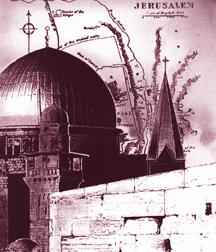
Kingdom of Israel, the ancient Hebrew State came into existence under King Saul in the 11th century BC, and reached its height under his successors, David and Solomon. According to the Old Testament, David brought the sacred Ark of the Covenant to Jerusalem from Qiryat Ye'crim (a holy place of the time, west of Jerusalem) and installed it in a new tabernacle, built a royal palace and other buildings, and strengthened the city's fortifications.
Although David greatly expanded the Kingdom of Israel and made Jerusalem its capital, the city and the temple he built were quite modest. Solomon, his son and successor, improved the temple and enlarged the city. He built a city wall and many buildings on a scale of magnificence previously unknown in Kingdom of Israel.
After Solomon's death in 922 BC, the country was divided into two parts. The name Israel was retained by the Northern Kingdom, with its capital at Samaria, near modern Nabulus. It was destroyed by the Assyrians in 722 BC. The southern kingdom, known as Judah, continued to exist until the 6th century BC. See map1